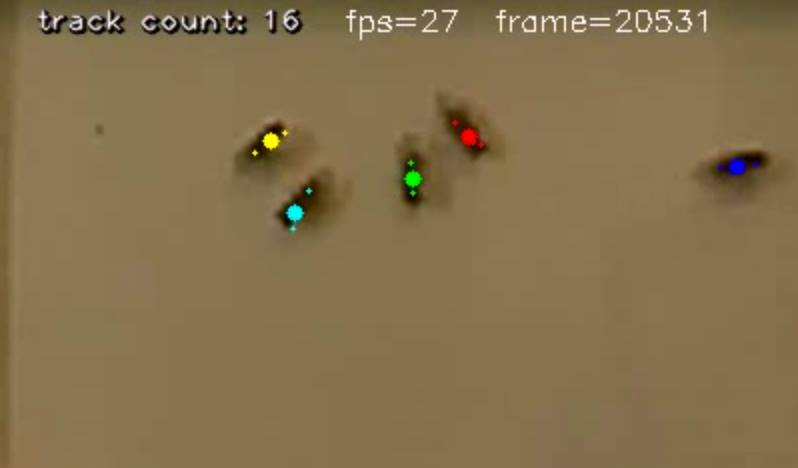
Time Flies: Interview with Andrea Soto Padilla on time perception
 Every quarter, we share articles published in the BCN Newsletter and we are happy today to share an interview with Andrea Soto Padilla, PhD candidate at the Faculty of Medical Sciences, who works on an interdisciplinary project on the perception of time. The interview was conducted and written by Manon van Asselt, a PhD candidate at UMCG.
Every quarter, we share articles published in the BCN Newsletter and we are happy today to share an interview with Andrea Soto Padilla, PhD candidate at the Faculty of Medical Sciences, who works on an interdisciplinary project on the perception of time. The interview was conducted and written by Manon van Asselt, a PhD candidate at UMCG.
 Short time perception is one of those strange abilities we are not really aware of. When you want to cross the street, you need time perception to make an estimation about how fast a car is approaching and then decide if you are going to cross the street or not. While most research about time perception is done in the fields of psychology and computational neuroscience, Andrea Soto Padilla was also intrigued by the topic and is currently investigating time perception in fruit flies. Although this animal model seems a strange choice, she explains how we can take advantage of Drosophila melanogaster to understand how time perception works in the brain.
Short time perception is one of those strange abilities we are not really aware of. When you want to cross the street, you need time perception to make an estimation about how fast a car is approaching and then decide if you are going to cross the street or not. While most research about time perception is done in the fields of psychology and computational neuroscience, Andrea Soto Padilla was also intrigued by the topic and is currently investigating time perception in fruit flies. Although this animal model seems a strange choice, she explains how we can take advantage of Drosophila melanogaster to understand how time perception works in the brain.
Manon van Asselt: How did this idea to study time perception in fruit flies arise?
Andrea Soto Padilla: It all started with my two co-supervisors: Hedderik van Rijn from the Department of Psychology and Jean-Christophe Billeter from GELIFES. They started talking to each other about their research and suddenly realized there was no model in fruit flies for time perception in the interval timing range, which is seconds to minutes. So they had an amazing opportunity to do something new and started planning the creation of a suitable method. At that time, I came to Hedderik as a master student and said that I really wanted to study this type of time perception. So he introduced me to the project and I thought it was really fascinating. I really liked the chance of doing something new. Ody Sibon from the medical faculty got involved soon after and luckily we got the funding to continue the research through a PhD.
MvA: Can you tell us a little bit more about the experiment?
ASP: Basically we use a box that has three copper tiles on which the temperature can be controlled. Flies are very sensitive to temperature changes, so when it gets a little bit too hot for them they will walk away. We put the flies into the box and play a sound that is either long or short and we are trying to condition the flies to go to the left on the long sound and to go to the right on the short sound. The conditioning comes from pairing these sounds with the temperature changes. We try to prove that flies can use temporal information by understanding that one tone is short and the other long and using this to decide which direction to move to. Our pilot study had really promising results. Now we are trying to replicate the results, improve it and make the method a little bit cleaner.
“Non-scientists think it is awesome because they are fascinated by the fact that flies have a brain and that flies can be used for something.”
MvA: What is the general reaction you get when you talk to people about your research?
ASP: Well, it depends on which group of people I am talking to. Non-scientists think it is awesome because they are fascinated by the fact that flies have a brain and that flies can be used for something. I think that is kind of funny, because fly research has existed for over a hundred years. When I talk to students or professors that are doing something non-related to my project, the general reaction is ‘wow, you’re doing something new, that’s awesome!’ When I talk to people that are related to the project in the psychology department, they often immediately classify me as a ‘fly person’. The general reaction that I get is that they think it is kind of weird, but that it is really cool if it works. When I talk to fly experts, they assume that flies can do it, so they are not surprised that we are trying to research this in flies. But at the same time, they wonder how we are going to demonstrate that they can perceive time. In the fly community there is a really broad debate on techniques, and your methods have to be extremely clean for your research to be acceptable.
MvA: You probably get in contact with a lot of different departments.
ASP: Yes, I realized that people from different departments communicate differently. They have the same idea but use different words. So you become bicultural. But that is a really good thing for the future, because at the end you have to deal with people with different backgrounds. So having some expectation about how they prefer things done helps to be more efficient.
“Flies have answered some questions that vertebrates could not because flies allow genetic and molecular techniques that do not exist in vertebrates yet, and permit us to do really specific manipulations to understand how genes and behavior relate.”
MvA: When I read your project description on the website of the RUG, I had to laugh, because you describe the Drosophila melanogaster as the ‘infamous fruit fly’. Do you think the fruit fly gets enough credit?
ASP: Well, not as much as it should (laughing). Seriously, a great part of the non-scientific audience does not realize that research requires animal models and that animal models go beyond the classic mice or rats. We can use a lot of species for different questions. Flies have answered some questions that vertebrates could not because flies allow genetic and molecular techniques that do not exist in vertebrates yet, and permit us to do really specific manipulations to understand how genes and behavior relate. When it comes to the scientific community, I think the fly research is generally seen as very basic by some and hence they demand a lot of details from each experiment; but most realize that flies are important and appreciate the research done with them. Within the fly world, nobody is saying that the fly is the only answer, just that it is an amazing and interesting blue print of our own species. Results in flies can guide research in areas such as behavior, neurodegeneration, aging, and even psychiatric disorders by providing a relatively simple animal that is easy to manipulate. Others will use the results for their own models.
MvA: What would be the next step after you show that flies have time perception in seconds to minutes range?
ASP: The next step would be to do some tests with different mutants, to come up with an idea of what mechanism and pathways the flies are using. Once we have mapped out where the possible areas are that are related to time perception, we can use different genetic and molecular techniques to explore these areas further and try to narrow it down to the basic neuronal structures. Then we could use other techniques to explore individual cells, particular neurotransmitters or specific genes. Hopefully at the end we will know how flies manage to perceive time in the seconds to minutes range.




